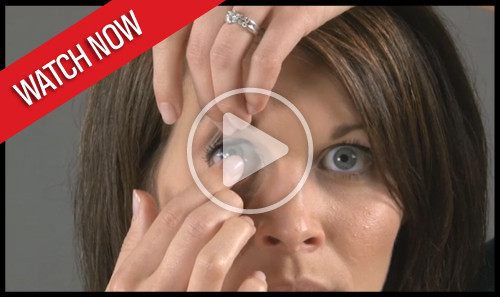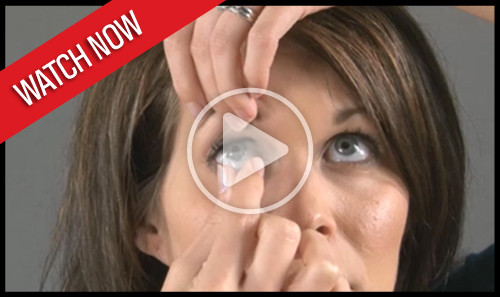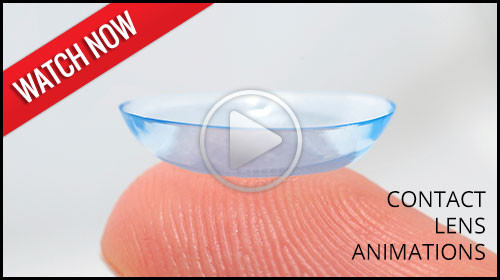If you would like to order your prescription contacts online, please visit our webstore: https://www.yourlens.com/hinsdaleeye
Contact lenses, when used properly, are very convenient and, with the latest advancements in technology, are extremely comfortable. Contact lenses are small lenses worn on the surface of the eye to correct vision.
We are happy to discuss the options available for you. Many patients choose contact lenses for their primary vision correction and glasses for an alternative or part-time wear.
Many patients prefer to wear glasses for the majority of their day, but have activities and events where they'd rather not wear their glasses and choose contact lenses for these times.
If you are a first-time wearer, click here for wearing instructions.
Contact Lens Types
The type of contact lenses available has grown greatly in the past five years. There are now contact lenses available for almost everyone. New contacts are being introduced every year, meaning many of our patients who were unable to wear contacts in the past are finding great success with them now. You owe it to yourself to see what is new. We carry many options, and promise to do our best in selecting contact lenses that you will love wearing. The following is a brief list of some of the options available. During your contact lens appointment a significant portion of the exam is spent discussing your visual needs in order to determine which contact lens style and design will best suite you.
Conventional Soft Lenses
Soft lenses are very comfortable and come in a variety of types, depending on the wearer’s needs. Conventional soft lenses are worn during the day, and cleaned and stored at night in an enzymatic cleaner, which removes protein deposits. These lenses can last for a year or more if your prescription stays the same and you take good care of them.
Frequent Replacement Soft Lenses
These lenses are similar to conventional soft lenses except they are replaced more frequently. Oftentimes, they are worn for one-month periods and then replaced. Other frequent replacement soft lens types are worn two to three months before they are replaced. Like conventional soft lenses, they have to be cleaned and stored at in an enzymatic cleaner to remove protein deposits.
Disposable Soft Lenses
Disposable soft lenses are much more popular than conventional soft lenses. These lenses are worn for a period of time and then, of course, thrown away. The most well-known disposables last for two weeks. There are also one-week and one-day disposables. These are perfect for many patients who were told they could not wear contact lenses because of allergies or mild dry eye conditions. They have a low cost per lens and are also popular for athletes and hobbyists who do not necessarily want to wear contact lenses every day. We are able to have lenses shipped directly to your home for your convenience. We have many diagnostic lenses in office for a more efficient contact lens fitting experience.
Soft Colored Contact Lenses
Next, you have tinted soft lenses, available in conventional, disposable, or frequent replacement types. With tinted soft lenses, you can change or enhance your eye color. Even if you do not need corrective lenses, you can use “plano” colored contacts to change your eye color. It is important to be fitted by an eye doctor for colored contact lenses even if you do not need a prescription; wearing the wrong style can damage your eyeball.
Bifocal Soft Lenses
Recent technology has greatly improved bifocal soft lenses. Many patients past their 40s who need bifocals can now enjoy the comfort and benefits of soft contact lenses.
Toric Soft Lenses
Toric lenses are used to correct astigmatism. Astigmatism is a vision condition where an irregularly shaped cornea affects the vision. In the past, the only options for those with astigmatism were either glasses or hard gas permeable contact lenses. But toric lenses, which are lenses with a special shape, now offer an alternative.
Rigid Gas Permeable (RGP) Lenses
As the name implies, these lenses are hard and gas permeable. If you’ve been told you cannot wear soft lenses, RGP lenses are often a great alternative. RGP lenses are available in specialized designs to correct just about any vision disorder.
Specialty Contact Lenses
Hinsdale Advanced Eye Care is pleased to offer contact lenses designed to treat medical conditions. Visually impacting conditions such as Keratoconus, Pellucid Marginal Degeneration, Severe Dry Eye, post Lasik and RK ectasia and other conditions may impact your vision. It has been shown that specialty contact lenses can often correct vision in these conditions better than traditional contact lenses or glasses.
Corneal Reshaping Therapy
Corneal Reshaping Therapy is a unique technology worn overnight to improve vision during the day. Dr. Adamo is pleased to offer this as a replacement for traditional contact lenses or as an alternative to other permanent options such as Lasik. This is also a treatment using to slow the progression of Myopia in children. It has been shown that the rate of progression of myopia has increased compared to previous generations. CRT can help to slow the progression of myopia or near sightedness and protect our childrens' eyes.
Solutions
There are a variety of solutions available from many different manufacturers. The important thing to remember is that not every solution is right for every type of contact lens. Some contact lenses require the use of multipurpose solutions, while others require separate solutions for the four steps in contact lens care: disinfecting, cleaning, rinsing, and enzyming. Use only the lens solutions that are recommended by the eye doctor. If you wish to change brands, check with our office first.
Contact Lens Instructions
Few things affect the quality of your life more than your eyes-never put them at risk. Contact lenses are prescription medical devices. To make sure your eyes and vision stay healthy while wearing contact lenses, please follow these few guidelines or the instructions recommended by your doctor.
Ocular complications and/or long-term corneal damage are the consequences of contact lenses that are worn longer than recommended. Oftentimes, your lenses will still feel good even when you are over-wearing them. Do not wear your lenses overnight unless they are approved for extended wear and your doctor has discussed this with you. Overnight wear increases the risk of infection and other complications.
Wearing Schedule
It will take at least a few days for your eyes to get used to wearing contact lenses. The best way to insure maximum visual comfort and keep your eyes healthy is to patiently and faithfully adhere to this wearing schedule.
| Day | Gas Permeable Lenses | Soft Lenses |
| 1 | 4 hours | 6 hours |
| 2 | 6 hours | 8 hours |
| 3 | 8 hours | 10 hours |
| 4 | 10 hours | 12 hours |
| 5 | 12 hours | 12 hours |
Oftentimes, your lenses will still feel good even when you are over-wearing them. Following are some basic Do's and Dont's of Contact Lens Care:
- DON'T wear your lenses overnight unless they are approved for extended wear and your doctor has discussed this with you. Overnight wear increases the risk of infection and other complications.
- DON’T wear your lenses longer than 12 hours a day until your first follow-up visit with your doctor, unless the doctor has specifically told you otherwise.
- DON’T continue use of contact lenses if your eyes become red, irritated, painful, or if your vision gets worse while wearing lenses. Immediately take out the lenses and clean them. Let your eyes get back to normal and if the problem persists, contact our office.
- DON’T exceed the wearing times suggested, even if your lenses still feel comfortable. Studies have proven that the eye needs time to adapt to contact lenses, and your wearing schedule is based on those studies.
- DO always remove your contact lenses at least one hour before going to bed to allow for proper oxygen nourishment to the cornea.
- DO wear your contact lenses for at least 3 hours before your follow-up appointment unless you are experiencing discomfort.
- DO schedule and keep follow-up appointments with your eye doctor.
Caring For Your Contacts
Deposits and infectious organisms such as bacteria, viruses--etc., can build up on the surface of all contact lenses. For this reason, it is very important to keep them clean and disinfected. The best way to care for your lenses is to follow the advice of the optometrist on how the take care of them!
There are Five steps in contact lens care—follow the care prescribed for your lenses:
- Cleaning removes dirt, mucous, and other debris that gets on the lenses during wear.
- Disinfecting kills bacteria (germs) on the lenses. Disinfecting is essential to prevent serious eye infections.
- Rinsing removes the other solutions from the lenses and prepares the lenses for wear.
- Enzyming uses enzyme drops or tablets to remove protein and other deposits that build up over time on the lenses.
- Replacing your lenses as directed. You can’t keep a worn out lens comfortable and safe by trying to clean it beyond when it is recommended to be replaced.
The best way to properly care for your lenses is to develop a care routine, then stick to it. Remember to:
- Follow the directions outlined by your eye doctor. Oftentimes instructions are also listed on the packaging or the package insert for the contact lens solutions prescribed for you.
- Multi-purpose solutions can be used for more than one step in contact lens care. Read the label to see which functions the solutions can be used for.
- Many solutions can not be used together, and not all solutions are appropriate for all types of lenses. Only use solutions recommended by your eye doctor, and check with your eye doctor if you want to switch brands.
- When you remove your lenses, they must be cleaned, rinsed, and disinfected before they are worn again.
- Enzyming and cleaning are not a substitute for disinfecting.
- Lenses that have been stored for more than 24 hours should be cleaned, disinfected, and rinsed again prior to wear
- Make sure solution containers are kept closed tightly, stored upright, and kept in a clean, dry, cool place when you are not using them. Keep your case clean and replace it every 3 months to prevent bacterial growth. In addition, cleaning the case with warm soapy water once a week, rinsing, and allowing it to air dry helps prevent bacterial buildup.
- Don’t touch container bottle tips to any surface to prevent them from becoming contaminated.
- Throw away expired solutions. (Look on the bottle for the expiration date!) A single contact lens wearer who wears contacts most days should be using about 8 bottles (12 fl oz) a year of multiple purpose solution to clean and store soft contacts. If you using substantially less than this, you are probably not adequately cleaning your contact lenses.
- Use new solution in your contact lenses case every day sufficient to fully submerge the contact lenses in its case.
- Discuss with your eye doctor the care for your lenses if you wear them while swimming in a pool, lake, or hot tub.
- Only use approved rewetting drops for lubricating or wetting your lenses. Never place the lenses in your mouth. (Yuck!)
- Do not use tap water to rinse soft contact lenses.
- Be careful with makeup, lotions, creams and sprays--consider putting on lenses before makeup and remove them before removing makeup. Also, water-based makeup is less likely to damage lenses than oil-based makeup.
Here’s what you need to watch for: Redness, blurriness, light sensitivity. Remove your lenses if you are experiencing any of these 3 things. If severe symptoms are present, contact our office immediately. Otherwise, if your eyes have not returned to normal after 24 hours, please contact our office. If you have any change in vision, comfort, or irritation, immediately remove your lenses. If there is no improvement within a couple of hours, please contact our office.






